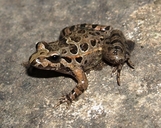|
Description
There are three pattern variations in this species: almost uniformly colored
animals; animals with large dark spots with bright edges and animals with two
dark brown longitudinal bands, one bright band along the back and two bright
bands along the sides. The belly is whitish.
The body is stout with a flat head that is wider than it is long.
The dorsal glands are arranged in longitudinal patterns along the back, or
can be absent.
The pupil is shaped like an upside-down droplet
(Noellert and Noellert 1992).
D. galganoi is similar in appearance to D. jeanneae, but can
be distinguished from the latter by biochemical and morphometric
characteristics (Busack 1986). The distinction between D. jeanneae
and D. galganoi is also supported by phylogenetic work based upon
mitochondrial sequences (Garcia-Paris and Jockusch 1999).
Distribution and Habitat
Country distribution from AmphibiaWeb's database: Portugal, Spain
D. galganoi is endemic to the Iberian Peninsula. It inhabits Portugal
and the western part of Spain. Previous studies separated vD. galganoi from D. jeanneae, which inhabits the eastern part of Spain by the
Guadalquivir river in the southern part of its distribution, and by the
saline lakes in the central part of the Iberian Peninsula, with contact zones
between the two species in the eastern portion of the Sierra
Morena, near the Sierra de Guadarrama and along the northwestern edge of
the Meseta Norte (Garcia-Paris and Jockusch 1999). However more recent studies consider D. jeanneae a subspecies or too closely related lineage to differentiate genetically. See Speybroeck et al 2020 for a summary.
This frog is mostly found in or in the direct vicinity of water.
They are found in stagnant waters, in swamps and mountain streams and even
in brackish waters (Noellert and Noellert 1992).
Life History, Abundance, Activity, and Special Behaviors
The reproductive period of D. galganoi starts in October, and ends in
late summer. During this period, the female can produce up to six clutches,
each of 300 to 1500 eggs. Over the entire breeding season, she can produce
as many as 4900-5600 eggs. Each female mates with a number of males, and each
mating she produces 20 to 50 eggs. These eggs are laid singularly or as small
clumps on the bottom, or are attached to plants. Eggs have a diameter of
1.5-2 mm, the gelatinous envelope measuring 6-8 mm. Depending on water
temperature, the embryonic development takes 2 to 6 days. Larvae are
3mm in length upon hatching, and grow to a total length of 25 to 35 mm.
The diurnal larvae are mostly found in December, March and May. Larval
development takes 22 to 60 days, and newly metamorphosed frogs have a
snout-vent length of about 10 mm. Sexual maturity is reached at an age
of 3-5 years for males, and at an age of about 4 years for females. Total
life span is estimated at about 9 years.
D. galganoi is active when water temperatures rise above 9°C.
The optimum temperatures for this species is between 21 and 30°C.
The animals become inactive when the relative humidity of the air drops
below 45% (Noellert and Noellert 1992).
Trends and Threats
This species seems to be abundant throughout its entire range.
As an ubiquitous frog species it is not endangered by specific threats;
however, marginal and sparse populations, which possibly represent
distinct genetic lineages, are threatened and in some cases became
extinct because of the destruction of their habitats (Gasc 1997).
Possible reasons for amphibian decline General habitat alteration and loss
Comments
Speybroeck et al (2020) summarizes molecular studies on Discoglossus and notes that the broad hybrid zone between galganoi and jeanneae, lack of monophyly based on nuclear data, evidence of introgression, and generally lack of barriers to gene flow support treating these as the same species.
References
Busack, S. D. (1986). ''Biochemical and morphological differentiation in Spanish and Moroccan populations of Discoglossus and the description of a new species from southern Spain (Amphibia, Anura, Discoglossidae.'' Annals of Carnegie Museum, 55, 41-61.
Garcia-Paris, M., and Jockusch, E. L. (1999). ''A mitochondrial DNA perspective on the evolution of Iberian Discoglossus (Amphibia: Anura).'' Journal of Zoology, (248), 209-218.
Gasc, J.-P. (1997). Atlas of Amphibians and Reptiles in Europe. Societas Europaea Herpetologica, Bonn, Germany.
Nöllert, A. and Nöllert, C. (1992). Die Amphibien Europas. Franckh-Kosmos Verlags-GmbH and Company, Stuttgart.
Speybroeck, J., W. Beukema, C. Dufresnes, U. Fritz, D. Jablonski, P. Lymberakis, Í. Martínez-Solano, E. Razzetti, M. Vamberger, M. Vences, J. Vörös, and P.-A. Crochet (2020). "Species list of the European herpetofauna—2020 update by the Taxonomic Committee of the Societas Europaea Herpetologica." Amphibia-Reptilia, 41, 139-189. [link]
Originally submitted by: Arie van der Meijden (first posted 1999-09-07)
Edited by: Vance T. Vredenburg and Arie van der Meijden, Tate Tunstall 2/11/04 (2021-03-23)Species Account Citation: AmphibiaWeb 2021 Discoglossus galganoi: Iberian Painted Frog <https://amphibiaweb.org/species/5581> University of California, Berkeley, CA, USA. Accessed May 31, 2025.
Feedback or comments about this page.
Citation: AmphibiaWeb. 2025. <https://amphibiaweb.org> University of California, Berkeley, CA, USA. Accessed 31 May 2025.
AmphibiaWeb's policy on data use.
|





 Map of Life
Map of Life